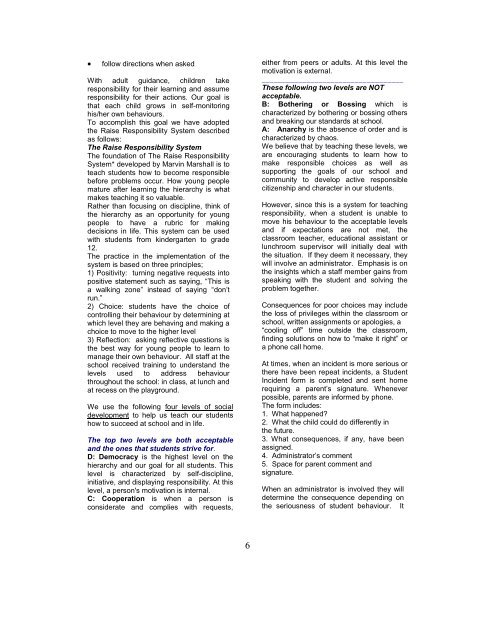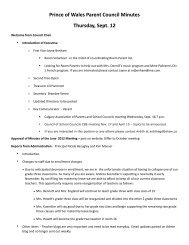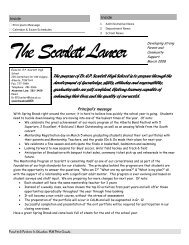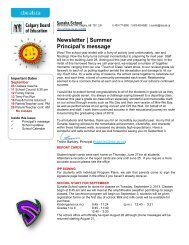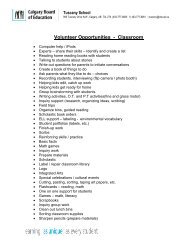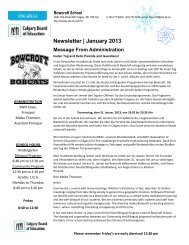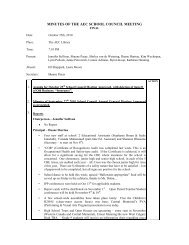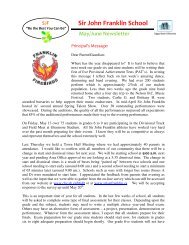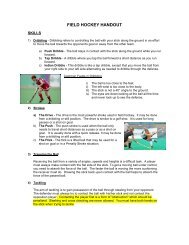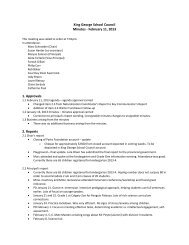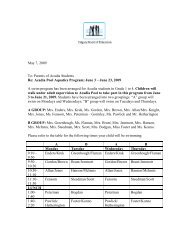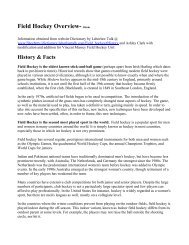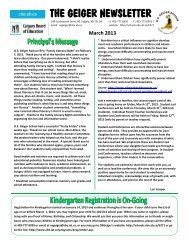to see Parent Handbook - Calgary Board of Education
to see Parent Handbook - Calgary Board of Education
to see Parent Handbook - Calgary Board of Education
Create successful ePaper yourself
Turn your PDF publications into a flip-book with our unique Google optimized e-Paper software.
follow directions when asked<br />
With adult guidance, children take<br />
responsibility for their learning and assume<br />
responsibility for their actions. Our goal is<br />
that each child grows in self-moni<strong>to</strong>ring<br />
his/her own behaviours.<br />
To accomplish this goal we have adopted<br />
the Raise Responsibility System described<br />
as follows:<br />
The Raise Responsibility System<br />
The foundation <strong>of</strong> The Raise Responsibility<br />
System* developed by Marvin Marshall is <strong>to</strong><br />
teach students how <strong>to</strong> become responsible<br />
before problems occur. How young people<br />
mature after learning the hierarchy is what<br />
makes teaching it so valuable.<br />
Rather than focusing on discipline, think <strong>of</strong><br />
the hierarchy as an opportunity for young<br />
people <strong>to</strong> have a rubric for making<br />
decisions in life. This system can be used<br />
with students from kindergarten <strong>to</strong> grade<br />
12.<br />
The practice in the implementation <strong>of</strong> the<br />
system is based on three principles;<br />
1) Positivity: turning negative requests in<strong>to</strong><br />
positive statement such as saying, “This is<br />
a walking zone” instead <strong>of</strong> saying “don’t<br />
run.”<br />
2) Choice: students have the choice <strong>of</strong><br />
controlling their behaviour by determining at<br />
which level they are behaving and making a<br />
choice <strong>to</strong> move <strong>to</strong> the higher level<br />
3) Reflection: asking reflective questions is<br />
the best way for young people <strong>to</strong> learn <strong>to</strong><br />
manage their own behaviour. All staff at the<br />
school received training <strong>to</strong> understand the<br />
levels used <strong>to</strong> address behaviour<br />
throughout the school: in class, at lunch and<br />
at recess on the playground.<br />
We use the following four levels <strong>of</strong> social<br />
development <strong>to</strong> help us teach our students<br />
how <strong>to</strong> succeed at school and in life.<br />
The <strong>to</strong>p two levels are both acceptable<br />
and the ones that students strive for.<br />
D: Democracy is the highest level on the<br />
hierarchy and our goal for all students. This<br />
level is characterized by self-discipline,<br />
initiative, and displaying responsibility. At this<br />
level, a person's motivation is internal.<br />
C: Cooperation is when a person is<br />
considerate and complies with requests,<br />
either from peers or adults. At this level the<br />
motivation is external.<br />
___________________________________<br />
These following two levels are NOT<br />
acceptable.<br />
B: Bothering or Bossing which is<br />
characterized by bothering or bossing others<br />
and breaking our standards at school.<br />
A: Anarchy is the absence <strong>of</strong> order and is<br />
characterized by chaos.<br />
We believe that by teaching these levels, we<br />
are encouraging students <strong>to</strong> learn how <strong>to</strong><br />
make responsible choices as well as<br />
supporting the goals <strong>of</strong> our school and<br />
community <strong>to</strong> develop active responsible<br />
citizenship and character in our students.<br />
However, since this is a system for teaching<br />
responsibility, when a student is unable <strong>to</strong><br />
move his behaviour <strong>to</strong> the acceptable levels<br />
and if expectations are not met, the<br />
classroom teacher, educational assistant or<br />
lunchroom supervisor will initially deal with<br />
the situation. If they deem it necessary, they<br />
will involve an administra<strong>to</strong>r. Emphasis is on<br />
the insights which a staff member gains from<br />
speaking with the student and solving the<br />
problem <strong>to</strong>gether.<br />
Consequences for poor choices may include<br />
the loss <strong>of</strong> privileges within the classroom or<br />
school, written assignments or apologies, a<br />
“cooling <strong>of</strong>f” time outside the classroom,<br />
finding solutions on how <strong>to</strong> “make it right” or<br />
a phone call home.<br />
At times, when an incident is more serious or<br />
there have been repeat incidents, a Student<br />
Incident form is completed and sent home<br />
requiring a parent’s signature. Whenever<br />
possible, parents are informed by phone.<br />
The form includes:<br />
1. What happened?<br />
2. What the child could do differently in<br />
the future.<br />
3. What consequences, if any, have been<br />
assigned.<br />
4. Administra<strong>to</strong>r’s comment<br />
5. Space for parent comment and<br />
signature.<br />
When an administra<strong>to</strong>r is involved they will<br />
determine the consequence depending on<br />
the seriousness <strong>of</strong> student behaviour. It<br />
6


